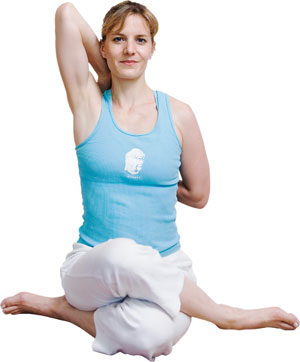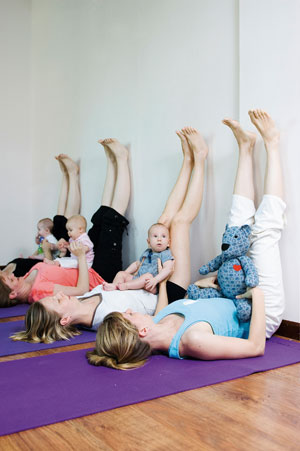 After giving birth, new mothers often feel physically exhausted, run-down, and weak. Jodi Noffsinger Hwang would know – she’s a former marathon runner and yoga teacher at the Yoga Yard who found it almost impossible to make time to exercise following the birth of her son, Kai (now 2 years old). Hwang teaches pre- and postnatal yoga and says one of the biggest problems women face when looking to regain their pre-baby bodies is maintaining a regular exercise schedule. “I wouldn’t call that a mistake but it’s an obstacle – your body needs time to heal,” says Hwang.
After giving birth, new mothers often feel physically exhausted, run-down, and weak. Jodi Noffsinger Hwang would know – she’s a former marathon runner and yoga teacher at the Yoga Yard who found it almost impossible to make time to exercise following the birth of her son, Kai (now 2 years old). Hwang teaches pre- and postnatal yoga and says one of the biggest problems women face when looking to regain their pre-baby bodies is maintaining a regular exercise schedule. “I wouldn’t call that a mistake but it’s an obstacle – your body needs time to heal,” says Hwang.
During the initial months following the birth, it’s very difficult to separate from your child, both emotionally and physically. However, it is important for women to start an exercise routine as soon as they can: Exercise helps rebuild the physical strength mothers will need to care for their children, as well as control your emotional well-being by preventing mood swings caused by fluctuating hormones. A regular exercise routine will also force moms to take some much-needed alone time away from the family.
Most doctors recommend starting a fitness routine four to six weeks after giving birth. Eric Yue, Chief Physical Therapist at SinoUnited Health in Shanghai, says that, provided women have the go-ahead from their specialist, new mothers can start exercising as early as two weeks following delivery. However, it’s important to remember that most women won’t return to their former fitness levels for about a year after giving birth.
 Crystal Wang, a personal trainer from Powerhouse Gym, says that every woman is different. “Just because your friend looked great after three months [following birth], it doesn’t mean there’s something wrong with you if you are still struggling to return to your old body.” She says that regular exercise before and during pregnancy will greatly reduce the time it takes you to get back to your pre-pregnancy body.
Crystal Wang, a personal trainer from Powerhouse Gym, says that every woman is different. “Just because your friend looked great after three months [following birth], it doesn’t mean there’s something wrong with you if you are still struggling to return to your old body.” She says that regular exercise before and during pregnancy will greatly reduce the time it takes you to get back to your pre-pregnancy body.
Ease into Ab Rehab
Pregnancy and labor affects your pelvic floor muscles, causing them to weaken. This can result in stress incontinence (leaking urine when sneezing, for example) and decreased satisfaction during sex. Pelvic floor exercises during and after pregnancy can minimize these problems. Your doctor should explain which exercises are best.
Yue is quick to warn women against pushing themselves too hard, too fast. “Remember, it’s not just about exercising but exercising efficiently without putting the body at risk of injury.” An area women commonly focus on during their exercise regime is the abdominals, but burning through sit-ups will do little to flatten your stomach. In fact, Yue says, the majority of cases he sees are of women who have incorrectly exercised these muscles in an attempt to regain a taut tummy.
It’s important to realize that your core and your abdominals are two different things. The abdominals are the two muscles that run vertically along your stomach, whereas the core is made up of 29 muscles spanning from your shoulders to your pelvis – most of which you cannot see – but all of which contribute to your body’s overall stability. During pregnancy it is very common for the two abdominals to separate from each other as they stretch to accommodate the baby, causing a gap to grow between them. This condition, rectus diastasis, can be exacerbated by a long labor. When the abdominals separate, women may lose most of their core strength – their muscles can no longer hold them upright. Rectus diastasis commonly leads to lower back pain and pelvic instability.
Yue warns women against exercising their abdominals before they have returned to their correct position. Fortunately, this normally happens naturally over a period of time – however, for some women they may never return to their proper place. You can test the separation of these muscles by placing your fingers between them. Don’t start exercising your abdominals until the gap between them is less than two fingers wide (ideally, it should be less than one).
Hwang refers to the core muscles as the body’s “girdle,” and postnatal women should focus on these muscles, not the abdominals. In her post- and prenatal yoga classes, Hwang spends a lot of time concentrating on the core muscles to restore and maintain her students’ physical confidence.
 Find Workout Partners
Find Workout Partners
Hwang believes yoga is more suited to mothers than other forms of exercise because of its meditative aspects. “As a philosophy, it’s great for parenting. Knowing how to slow your breathing will help you respond to a crying baby. When you can slow down and take a breath it really helps.”
However, for overall fitness, postnatal exercise routines should not exclude light cardiovascular workouts and weight training. Wang recommends women start with low-intensity workouts such as Pilates, which focuses on developing core strength, flexibility, and pelvic floor area. The temptation to do a lot of heavy weight training should be avoided; instead, women should stick to lighter weights and increase repetitions over time. Wang says group classes are a good way for postnatal women to get back into a regular exercise schedule, as well as develop a support network of other women. Once you begin to feel more confident in your body and fitness routine, you should slowly increase the intensity to ensure your progression. Wang says that developing a personalized workout with a trainer is important, “It’s a good way to ensure you are not making any mistakes that might do more harm than good.”
Nutritional Needs
An exercise regime is only as good as the diet that supports it. Ivy Leung, a manager at the World Health Store and a naturopathy student, believes women can greatly improve their overall health given the right diet and supplements. Postnatal women have increased nutritional demands such as iron for post-partum hemorrhage, zinc for aiding metabolism, and bioflavonoids and vitamin C to aid healing after a Caesarean or perineal tear. Where these extra nutrients come from is vital. Leung recommends women eat foods that are high in fiber and low in fat to support the new requirements of their bodies. Your diet should include fruits, raw vegetables, balanced proteins such as chicken, fish and lean beef, and carbohydrates such as brown rice, whole wheat and grains. Women should avoid raw fish, smoked meats, alcohol, caffeine, unpasteurized cheese, trans fats and saturated fats.
Calcium is important for breastfeeding. Leung says it’s a good idea to take a supplement and eat calcium-rich foods. Taking the right amount of calcium gives you stronger bones, and studies have shown that postpartum women who have sufficient calcium in their diet are able to more easily reclaim their pre-pregnancy weight. It’s recommended your calcium intake be 12,000 milligrams during pregnancy and lactation, sourced from foods and calcium supplements. For best results, take a calcium supplement before bed, as calcium is more easily absorbed separately from other foods.
Other supplements recommended for postnatal women include omega-3 – rich in DHA – which is good for maintaining the health of your heart, as well as helping to reduce postnatal depression. Choose a quality omega-3, omega-6, or omega-9 fatty acid in oil or capsule form, making sure it’s low in mercury. A spirulina supplement should also be added as it’s very high in nutrients, including protein, iron, beta carotene, B vitamins and vitamin E. Spirulina also helps increase lactation in nursing mothers.
Try adding some spice to your diet – cinnamon, that is. Leung says it’s great for weight loss, especially in the area of the abdomen, and has a list of other benefits such as reducing appetite, and regulating insulin production and blood sugar levels. However, she warns women not to overdo it with this spice.
Breastfeeding and Your Body
Nursing mothers should increase their protein intake as much as 70 percent, but increase calorie intake by no more than 15 percent. To support increased protein needs, add a natural whey protein to your smoothies. Remember to keep hydrated while nursing, drinking at least nine to ten glasses of water per day. Leung suggests drinking purified and pH-adjusted water, while minimizing the amount of bottled juices and soft drinks you drink as they are surprisingly high in calories.
Though breastfeeding can be difficult, both Leung and Hwang strongly recommend women persist with it. The benefits to your baby are many, and nursing women lose weight faster thanks to the high number of calories burned while producing breastmilk and nursing. Hwang said she lost so much weight while breastfeeding that her pants hung off her hips, although her weight did regulate itself after a few months.
The number one rule of postnatal weight loss and fitness is to consult your doctor before making any drastic changes to your diet or exercise routine. Dieting post-pregnancy is dangerous both for you and your baby’s well-being. “The main goal should be a safe and permanent weight loss,” says Leung. A holistic approach is best, encompassing and healthy body, a healthy mind and healthy diet.
“It doesn’t mean there’s something wrong with you if you are still struggling to return to your old body”



